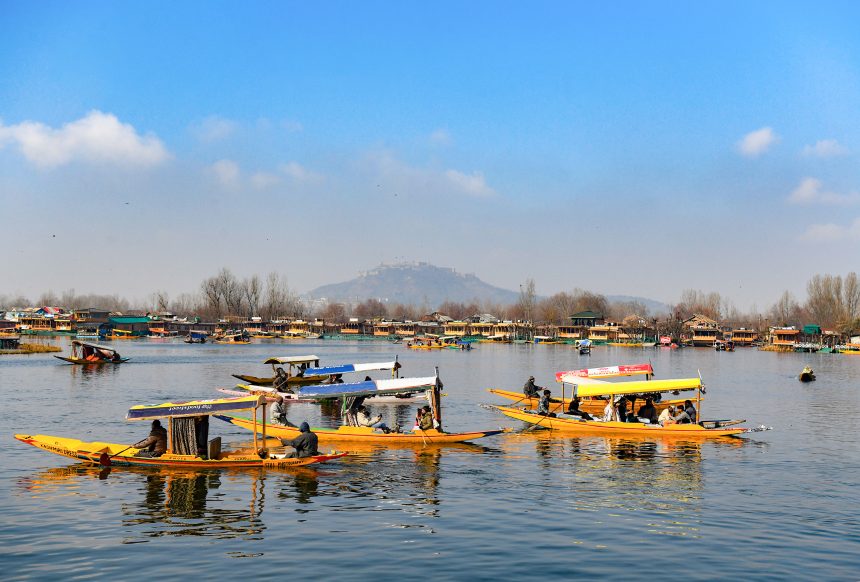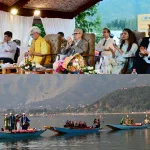Srinagar, May 29: Despite several government regulations and initiatives aimed at protecting the iconic Dal Lake, including the Jammu and Kashmir High Court’s 2014 ban on illegal constructions in and around the water body, illegal encroachments and construction continue unabated. These activities pose a serious threat to the lake’s delicate ecosystem and long-term sustainability.
Over the years, unauthorized structures — ranging from houses and shops to large commercial buildings — have steadily mushroomed along the lake’s banks and within its interior. Notably, areas like Harwan, Ishber, Baba Demb, Rainawari, Saidakadal, Dalgate, Kand Mohalla, Sofi Mohalla, Tinda Mohalla, and even the ‘Rakh-e-Arth’ resettlement colony, developed specifically for rehabilitating Dal dwellers, have witnessed an increasing number of such developments. Many of these unauthorized structures are built without the required permits, with construction materials often ferried via boats into the lake’s interior to bypass road access limitations and regulatory oversight. This practice has disrupted the lake’s natural water flow and contributed to the degradation of its delicate ecosystem.
Dal Lake, once sprawling over 75 square kilometers in 1200 AD, has now shrunk to just over 20.3 square kilometers — a stark indicator of how unchecked development has eroded the water body. Environmental experts and studies by the National Institute of Disaster Management (NIDM) and the Centre for Science and Environment (CSE) attribute this alarming reduction to unregulated construction, urban sprawl, and the expansion of floating gardens. Furthermore, according to CSE, over 50 percent of Srinagar’s lakes and wetlands have already been lost to such activities over the last century.
To address the crisis, the J&K government introduced a Rs 273-crore conservation plan that includes dredging, catchment area management, and sewerage improvements. Additionally, in 2014, the J&K High Court imposed a ban on the construction of any new illegal structures in and around Dal Lake. A committee was also set up to monitor the situation and recommend conservation strategies. While these measures were intended to protect the lake, they have had limited impact on curbing the growing encroachments and illegal constructions.
Environmentalists and social activists have expressed growing concern over the deteriorating state of Dal Lake. Many believe that current efforts lack the urgency and scale required to tackle the escalating crisis. Tariq Ahmad Patloo, a renowned social activist leading campaigns to save the lake, warned of irreversible consequences if timely action is not taken. “If we don’t act now, we may lose Dal Lake forever. Illegal constructions and flawed policies are pushing the lake to the brink,” he said. Patloo emphasized that enforcement alone will not suffice without political will, sustained community involvement, and a transparent policy framework prioritizing ecological restoration over unchecked development.
Responding to these concerns, a senior official at the Lake Conservation and Management Authority (LCMA), requesting anonymity, acknowledged the severity of the situation but pointed to limited manpower and logistical challenges hindering enforcement. “We carry out demolition drives with a handful of staff. Although we receive support from other departments, without adequate personnel and police protection, effective action remains difficult,” the official said.
According to official data, between September 23, 2024, and May 22, 2025, the LCMA carried out 399 demolitions of illegal structures, issued 71 notices against unauthorized developments, and registered 37 FIRs related to encroachments. The authority also seized 16 vehicles used in violations. However, despite these actions, the scale of encroachment continues to overwhelm available resources.
Officials say that while demolition drives serve as a deterrent, they are not enough to stop illegal construction. “There’s often political pressure, resistance from locals, and in some cases, legal hurdles that delay or halt action,” the official added.
Environmental experts believe that unless stricter enforcement is paired with community awareness and long-term ecological planning, the degradation of Dal Lake will continue. They stress the importance of involving local residents in conservation efforts, offering sustainable livelihood alternatives, and strictly monitoring land-use changes around the lake.
As illegal encroachments continue to shrink Dal Lake, the need for a long-term, effective solution has never been more urgent. Only through concerted efforts by the government, local communities, and environmental activists can this natural heritage be preserved for future generations.








